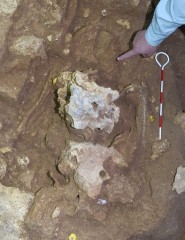Human bones dating back 9,000 years found at Sakitari Cave

At 11:28 a.m. on December 11, at Tamagusuku in Nanjo, human bones which appear to have been buried in Sakitari Cave were found. A finger points to a head with arms on the right and left, and a pelvis at the bottom.
December 11, 2014 Ryukyu Shimpo
On December 11, an official from the Okinawa Prefectural Museum and Art museum announced that they had found human bones dating back over 9,000 years at Sakitari Cave, located in the Valley of Gangala, Maekawa in Tamagusuku, Nanjo.
The bones were found with the head and upper body connected together. According to an official of the museum, the bones were possibly put into the land as burial. He said, “This indicates the possibility that people at that time used to use caves as graves.” In Okinawa, this is the first and oldest specimen of a connected skeleton found in its original position and not relocated.
Bones from one adult individual were discovered, with mainly upper-body parts such as the skull and arms, as well as the femur and pelvis. The bones were dug from about three meters beneath an excavation site near the entrance of Sakitari Cave. The bones were found in a posture lying flat and facing up, covered by four pieces of limestone about 30 centimeters in diameter, which suggests this was a deliberate burial.
While prehistoric human bones from the Paleolithic era, about 20,000 years ago, like the Minatogawa Man and the Shiraho Saonetabaru Cavemen, have previously been discovered in Okinawa, this is the first time a specimen with a connected skeleton has been found.
(English translation by T&CT and Lima Tokumori)
Previous Article:PTSD from Battle of Okinawa: sharing pain will help patients heal
Next Article:Governor Onaga to set up investigation team on former governor’s approval of Henoko landfill
[Similar Articles]
- Human bones and stone tools dating back 12000 years found in Nanjo
- Discovery of oldest East Asian full-body human skeleton at Shiraho Saonetabaru Cave Ruins
- World’s oldest fishing hooks from 23,000 years ago discovered in Sakitari Cave in Okinawa
- Quartz fragments and human remains excavated at Sakitari Cave, Tamagusuku, Nanjo City
- Okinawa is the “treasure trove” for discovering prehistoric human remains
 Webcam(Kokusai Street)
Webcam(Kokusai Street)


